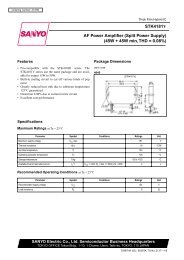TDA8358J Full bridge vertical deflection output circuit in ... - Laro
TDA8358J Full bridge vertical deflection output circuit in ... - Laro
TDA8358J Full bridge vertical deflection output circuit in ... - Laro
- No tags were found...
You also want an ePaper? Increase the reach of your titles
YUMPU automatically turns print PDFs into web optimized ePapers that Google loves.
Philips Semiconductors<strong>Full</strong> <strong>bridge</strong> <strong>vertical</strong> <strong>deflection</strong> <strong>output</strong> <strong>circuit</strong><strong>in</strong> LVDMOS with east-west amplifierProduct specification<strong>TDA8358J</strong>Notes1. To limit V OUTA to 68 V, V FB must be 66 V due to the voltage drop of the <strong>in</strong>ternal flyback diode between p<strong>in</strong>s OUTAand V FB at the first part of the flyback.2. Allowable <strong>in</strong>put range for both <strong>in</strong>puts: V I(bias) +V i < 1600 mV and V I(bias) − V i > 100 mV.3. This value specifies the sum of the voltage losses of the <strong>in</strong>ternal current paths between p<strong>in</strong>s V P and OUTA, andbetween p<strong>in</strong>s OUTB and GND. Specified for T j = 125 °C. The temperature coefficient for V loss(1) is a positive value.4. This value specifies the sum of the voltage losses of the <strong>in</strong>ternal current paths between p<strong>in</strong>s V P and OUTB, andbetween p<strong>in</strong>s OUTA and GND. Specified for T j = 125 °C. The temperature coefficient for V loss(2) is a positive value.5. The l<strong>in</strong>earity error is measured for a l<strong>in</strong>ear <strong>in</strong>put signal without S-correction and is based on the ‘on screen’measurement pr<strong>in</strong>ciple. This method is def<strong>in</strong>ed as follows. The <strong>output</strong> signal is divided <strong>in</strong> 22 successive equal timeparts. The 1st and 22nd parts are ignored, and the rema<strong>in</strong><strong>in</strong>g 20 parts form 10 successive blocks k. A block consistsof two successive parts. The voltage amplitudes are measured across R M , start<strong>in</strong>g at k = 1 and end<strong>in</strong>g at k = 10,where V k and V k+1 are the measured voltages of two successive blocks. V m<strong>in</strong> , V max and V avg are the m<strong>in</strong>imum,maximum and average voltages respectively. The l<strong>in</strong>earity errors are def<strong>in</strong>ed as:a) LE =V k – V k + 1------------------------- × 100% (adjacent blocks)V max – V m<strong>in</strong>b) LE = ------------------------------ × 100% (non adjacent blocks)6. The l<strong>in</strong>earity errors are specified for a m<strong>in</strong>imum <strong>in</strong>put voltage at p<strong>in</strong> 1 or p<strong>in</strong> 2 of 300 mV. Lower <strong>in</strong>put voltages leadto voltage dependent S-distortion <strong>in</strong> the <strong>in</strong>put stage.7.8. P<strong>in</strong> FEEDB not connected.9.G volV avgV avgV OUTA – V OUTB( ) = -------------------------------------------–V FEEDBV OUTBVG FEEDB – V OUTBV= -------------------------------------------–V INAV INB10. V P(ripple) = 500 mV (RMS value); 50 Hz < f P(ripple) < 1 kHz; measured across R M .11. This value specifies the <strong>in</strong>ternal voltage loss of the current path between p<strong>in</strong>s V FB and OUTA.12. This value specifies the <strong>in</strong>ternal voltage loss of the current path between p<strong>in</strong>s OUTEW and EWGND.13. Measured for R EWF =10kΩ; R EWL =30Ω; V o =6V.a) For I o = 100 mA and a voltage of 9 V at R EWL connected to the l<strong>in</strong>e <strong>output</strong> transformer, the east-west amplifier<strong>in</strong>put current (see Fig.4) is I i = 300 µA.b) For I o = 500 mA and a voltage of 21 V at R EWL connected to the l<strong>in</strong>e <strong>output</strong> transformer, the east-west amplifier<strong>in</strong>put current (see Fig.4) is I i = 350 µA.2002 Sep 25 9















